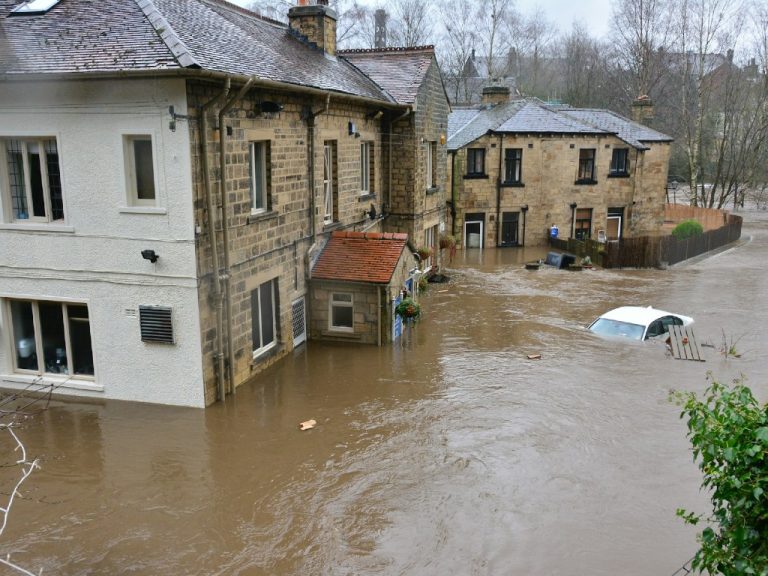A first national-scale analysis finds natural flood management could reduce residential flood damages by tens of millions of pounds by mid-century, when targeted effectively and combined with wider flood-risk measures.
Natural flood management (NFM) could make a measurable contribution to reducing fluvial flood risk across Great Britain, according to new research that quantifies its national benefits for the first time.
Fluvial flooding refers to river flooding – when rivers or streams overflow and inundate surrounding areas. The study, published in the Journal of Flood Risk Management led by Tyndall collaborator Paul Sayers, Sayers and Partners Limited, and including the Tyndall Centre’s Stephen Birkinshaw, Helen He, Liz Lewis, Ben Smith, Alistair Ford, Robert Nicholls, Jeff Price, Rachel Warren, Nicole Forstenhäusler and Adam Smith, examines how measures such as floodplain restoration, soil infiltration improvements and woodland planting could influence flood flows and economic damages under future climate and population scenarios.
Modelling future climate, population and land-use pressures
The analysis integrates two national-scale hydrological models (SHETRAN and HBV-TYN) with fluvial flood risk analysis (using the Future Flood Explorer, FFE) to test four levels of NFM policy ambition. Scenarios reflect two climate futures – 2°C and 4°C warming by 2100 – and population changes consistent with SSP4 (lower population growth) and SSP2 (higher population growth). The modelling also incorporates competing land-use demands, including urban development, agricultural productivity and biodiversity priorities, to determine where NFM is most feasible.
Some of the study’s authors are also involved in the Tyndall Centre for Climate Change Research’s OpenLAND project, which is developing national-scale land-use scenarios for climate mitigation, biodiversity and resilience. While OpenLAND is a separate research programme, it explores many of the same land-use pressures, including competing demands from agriculture, development and environmental restoration, which influence where NFM can be deployed.
Both of the hydrological models in this study project that NFM can reduce peak flows by up to around 10% during more frequent events, with greater reductions in the South and East, where catchments are drier and more responsive to changes in infiltration and storage. These differences are carried into the risk analysis, which evaluates how changes in flow affect downstream water levels, defence performance and overall flood probability.
Damage reduction of up to £120m by the 2050s
By the 2050s, an optimised approach to NFM is projected to reduce Expected Annual Damages (EAD) to residential properties by around £70-80 million under a 2°C, lower-growth scenario. Under a 4°C, higher-growth scenario, the reduction rises to approximately £105-120 million. This equates to roughly 9-13% of the total damage reduction achieved by the combined flood-risk management portfolio.
Some rural catchments, with limited existing flood defence infrastructure, see much higher shares, with NFM contributing up to about 80% of the portfolio’s benefits by mid-century.
By the 2080s, NFM’s contribution is projected to increase to roughly £110 million under a 2°C future and around £145 million under a 4°C future. While returns diminish as investment scales up, the study identifies a strong economic case for NFM, with optimal investment delivering benefit-to-cost ratios of around 3 to 5.
Although the analysis focuses only on reduced flood damages, the authors also emphasise that NFM delivers a far broader set of environmental and societal benefits. These include improvements to biodiversity, carbon storage, and landscape resilience. While these gains sit outside the economic analysis, the paper notes that these additional gains make the case for NFM even more compelling.
Role for NFM within adaptation portfolios
The study finds that NFM performs consistently across climate futures, supporting its use as part of a wider adaptation portfolio that includes raised defences, spatial planning, property-level measures and forecasting. The authors emphasise that NFM is not a standalone solution but can make a “significant” contribution when deployed in the right locations and alongside other measures.
The authors also look towards future analysis that would provide integrated insights into catchment development (including interactions across the rural/urban interface) and the best mixture of FRM measures, delivering wider benefits for people and nature. They note that achieving these benefits, and the broader opportunities NFM can offer, will require proactive landscape-scale planning that goes beyond flood management alone and creates aligned investment incentives that support sustainable outcomes for communities and the environment.
- Read the full journal article: “A National Assessment of Natural Flood Management and Its Contribution to Fluvial Flood Risk Reduction“
- Find out more about the OpenLAND research project










